From Jesse to Jude: Tracing the four stages of Gareth Southgate’s England evolution
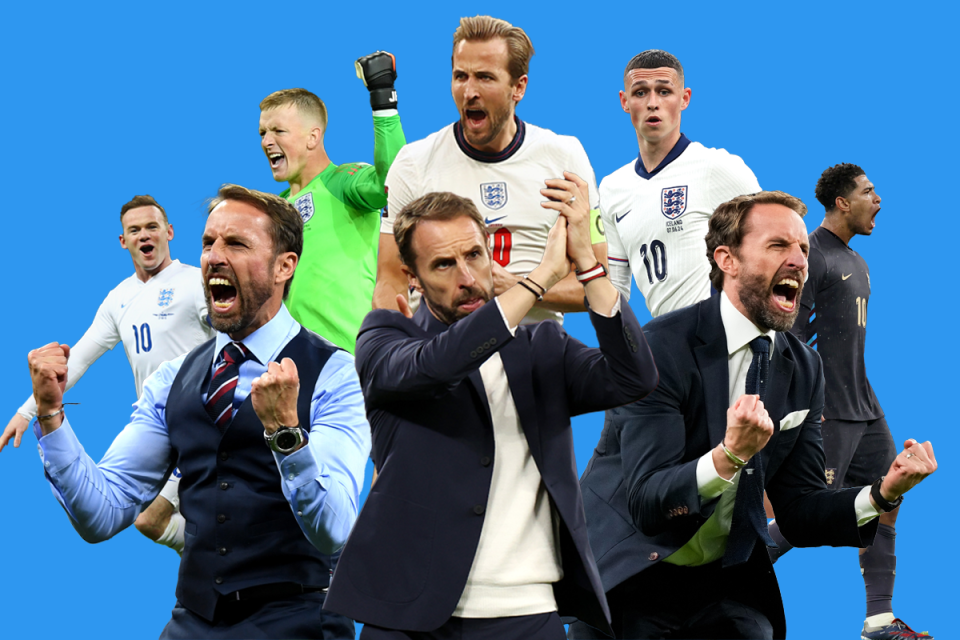
England have come a long way since Gareth Southgate’s first game as England manager, back in a distant dream when Joe Hart was in goal, Gary Cahill was the defensive rock and Theo Walcott was on the wing.
It hasn’t been quick, and it hasn’t been linear, but England are now a much better side than the one Roy Hodgson watched fall off a cliff at Euro 2016. Following England still ends in crushing disappointment, obviously. But now that disappointment comes with feelings of hope and pride and excitement about the next time, rather than a soul-crushing bout of existential dread.
That’s progress. England used to meet top-tier nations in knockout games with a defensive gameplan and hope that one of their superstars would do something special. Now they go toe to toe with the best, players pass the ball to each other confidently, in tight spaces, and try to impose their way. That’s progress too.
Yet this might be the end game – Southgate needs to win Euro 2024 or his journey is surely over. Can he harness the learnings of past tournaments to finally win one? Ahead of what might be his last hurrah, we trace the evolution of Southgate’s England from a humble qualifier back in 2016 through four eras to, perhaps, their final destination in Germany this summer.
Era I: The beginning
England 2-0 Malta, World Cup qualifier | Wembley Stadium, 8 October 2016
4-2-3-1: Hart; Walker, Cahill, Stones, Bertrand; Rooney, Henderson, Dele; Walcott, Lingard, Sturridge.
Southgate, the England Under-21’s manager, is parachuted in to take charge of the senior team after Sam Allardyce is caught on camera saying not a lot, in hindsight, while drinking a vase of wine.
The team is a blend of players Southgate will come to rely on – Kyle Walker, John Stones, Jordan Henderson – and players he will soon make tough calls to leave behind, like Joe Hart and the captain Wayne Rooney, who is deployed in midfield.
England win the qualifying game after goals by Daniel Sturridge and Dele Alli, and Southgate goes on to lead the team to unbeaten qualification for the 2018 World Cup, earning himself the permanent job on the way.
He plays a back four throughout qualifying but in the last game, and in all four warm-up friendlies before the World Cup, Southgate and his assistant Steve Holland decide to test out the back three with wing-backs that will become integral to their success.
England 1-2 Croatia (aet), World Cup semi-final | Luzhniki Stadium, 11 July 2018
3-5-2: Pickford; Walker, Stones, Maguire; Trippier, Dele, Henderson, Lingard, Young; Sterling, Kane.
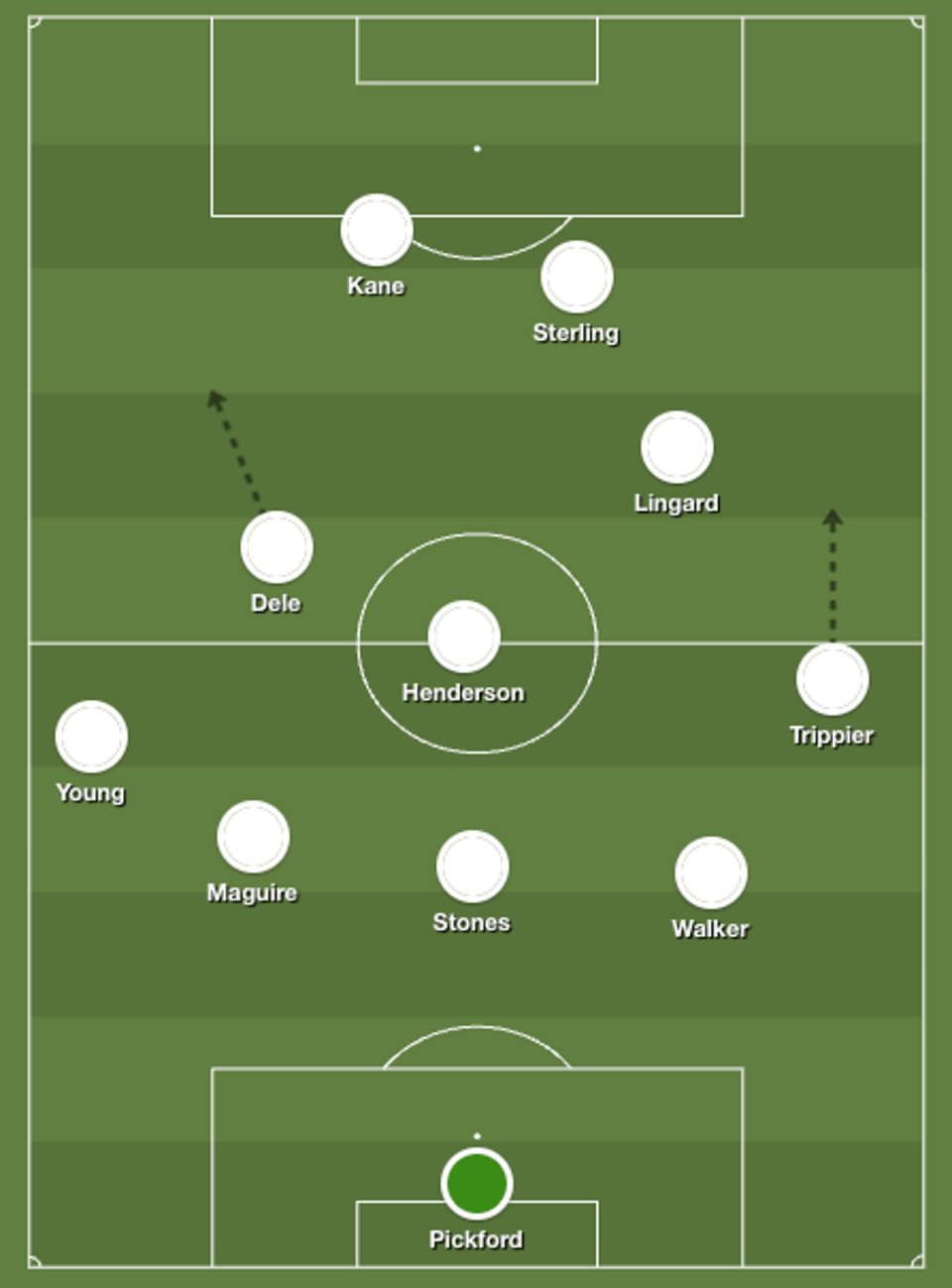
Southgate commits to his wing-back system at the World Cup in Russia, deploying Walker on the right of a back three alongside Stones and Maguire. Walker’s position is initially questioned by fans and the media, but the trio will prove to be the foundation of England’s defensive solidity over the coming years, in front of Jordan Pickford as the new No 1.
The use of Jesse Lingard and Dele Alli as attacking No 8s gives England plenty of energy in midfield, with Raheem Sterling and Harry Kane up front in a fruitful partnership. Kane wins the Golden Boot as England reach their first World Cup semi-final since Italia ‘90, but they run out of puff against Croatia in extra time, and finish the game chasing the shadows of Luke Modric, Ivan Rakitic and the rest.
The groundwork has been laid. But after failing to compete with the Croatians, Southgate resolves to build a more attacking, front-footed England team for Euro 2020.
Era II: The peak
Spain 2-3 England, Nations League | Sanchez-Pizjuan Stadium, 15 October 2018
4-3-3: Pickford; Trippier, Gomez, Maguire, Chilwell; Dier, Winks, Barkley; Sterling, Kane, Rashford.
After the World Cup, Southgate uses the inaugural Nations League to trial a back four in an effort to give England another system in their armoury.
It comes to fruition beautifully in Seville when England beat Spain 3-2, their first win on Spanish soil for more than 30 years, with a midfield that can euphemistically be described as ‘experimental’. Two goals by Raheem Sterling and one from Marcus Rashford have England leading 3-0 by half-time.
England 2-0 Germany, Euros round of 16 | Wembley Stadium, 29 June 2021
3-4-3: Pickford; Walker, Stones, Maguire; Trippier, Phillips, Rice, Shaw; Saka, Kane, Sterling.
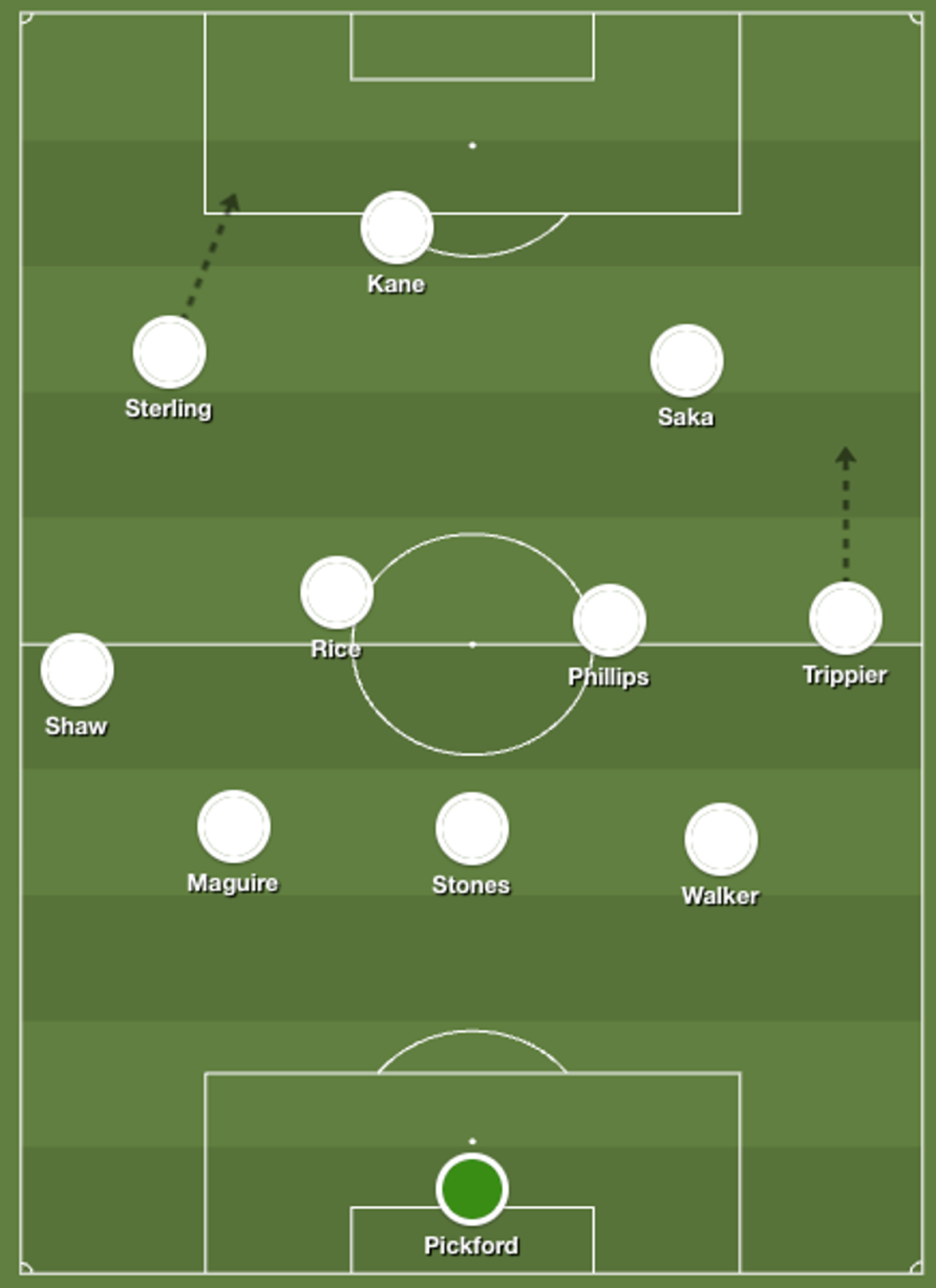
On the other side of the pandemic, Southgate takes a young, vibrant squad to the Euros featuring Phil Foden, Bukayo Saka, Mason Mount and Jack Grealish among a raft of tournament debutants.
England progress unconvincingly through the group stage using a back four before Southgate deploys their newfound tactical flexibility, springing wing-backs on Germany in the last-16. It works beautifully as England clinch a 2-0 victory, arguably still the greatest win of Southgate’s reign. It is their first knockout success over the Germans for 55 years.
But the same strategy doesn’t quite work in the final. After an early Luke Shaw goal, Italy assume control, equalise, and the game is lost on penalties. England’s half-century wait for a major trophy goes on.
Amid penalty pain and a drug-fuelled mob storming Wembley, and after the subsequent racist abuse of England’s players, it is understandably forgotten that Southgate made a huge call to use the back three which beat Germany, rather than the back four which saw off Ukraine and Denmark in the later rounds. Did his innate pragmatism hold England back?
Era III: The trough
England 0-4 Hungary, Nations League | Wembley Stadium, 14 June 2022
4-3-3: Ramsdale; Walker, Stones, Guehi, James; Gallagher, Phillips, Bellingham; Bowen, Kane, Saka.
Six months out from the World Cup, Southgate plays an attacking but inexperienced line-up in a 4-3-3 system, and they are torn apart by Hungary at Wembley, falling to their worst home defeat since the 1920s.
Questions are asked over whether Southgate is the right manager to lead the team into the winter tournament in Qatar. It is their fourth successive game without a win and he is forced to defend his record.
“The Nations League campaigns have put negativity and pressure onto us,” he says, referring to the way the new competition has replaced friendlies. “It is my job to protect the players, the results are my responsibility. We have had some unbelievable nights with England over the last four or five years but this is the other side and that is the reality of football.”
England 1-2 France, World Cup quarter-final | Al Bayt Stadium, 10 December 2022
4-3-3: Pickford; Walker, Stones, Maguire, Shaw; Henderson, Rice, Bellingham; Saka, Kane, Foden.
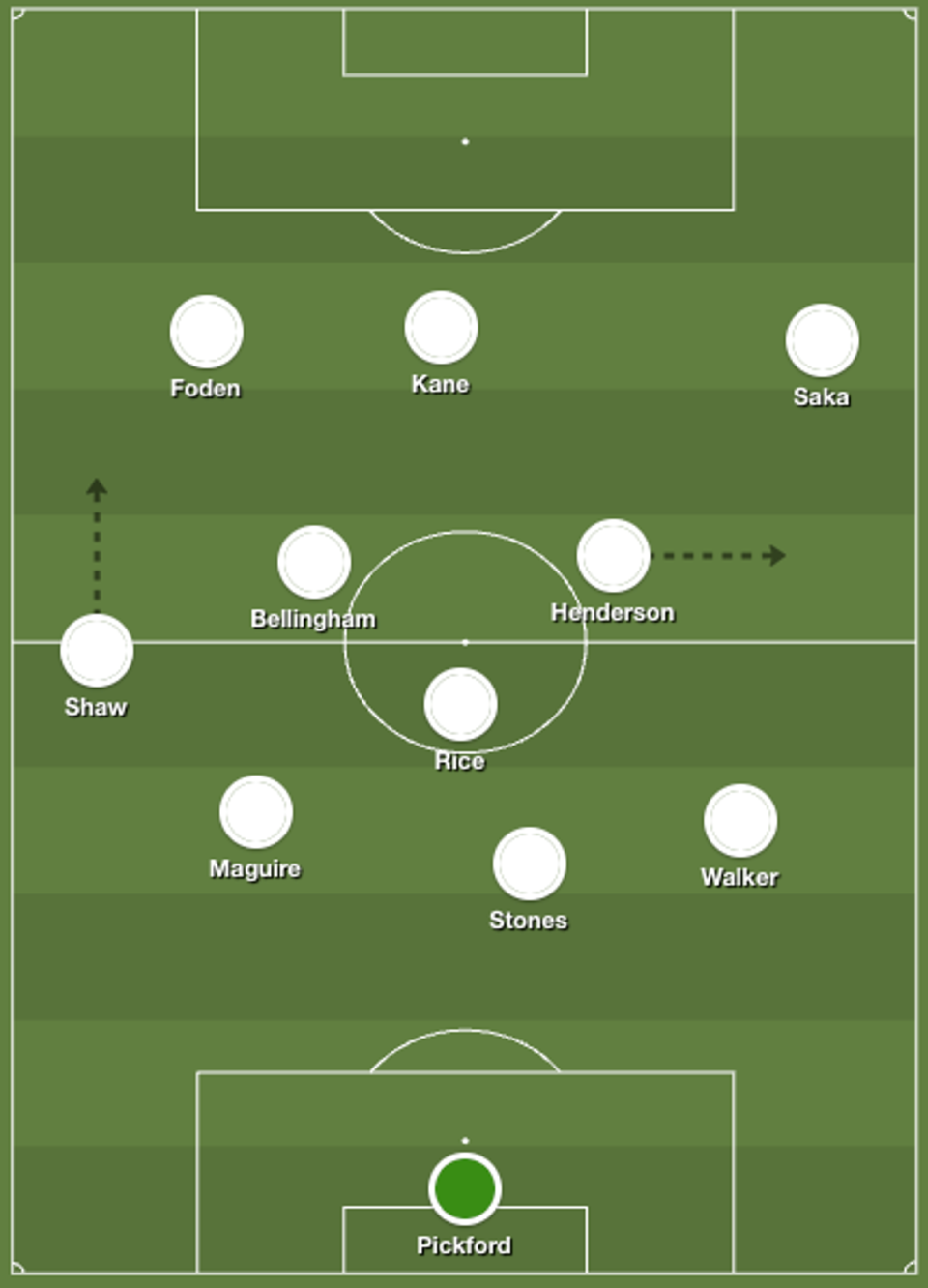
Despite mixed results, Southgate fully invests in a 4-3-3 formation that sees England on the front foot, trying to dominate their opponents.
In contrast to the Euros, he sticks with the plan even against a giant like France in the quarter-finals, and to some degree it works: England go toe to toe, creating several clear chances and dominating in spells. They are aggrieved by a possible foul on Saka in the build-up to Aurelien Tchouameni’s opening goal, and rue Kane’s late penalty miss as they go out of the tournament.
A strange dichotomy fills the aftermath. On the one hand, a quarter-final defeat is England’s worst return from a tournament yet under Southgate; on the other, he has successfully evolved the team into something genuinely competitive with the best nations, without needing to be cagey or cautious. England are showing progress, but results are king, and another year goes by without a trophy.
How England have evolved under Southgate
Era IV: The last dance?
England 3-1 Italy, Euros qualifier | Wembley Stadium, 17 October 2023
4-2-3-1: Pickford; Walker, Stones, Maguire, Trippier; Phillips, Rice; Foden, Bellingham, Rashford; Kane.
A landmark moment: it is the first time since beating Spain five years earlier that England have beaten a major nation while playing a back four, even if it is a wayward Italian side who failed to qualify for the previous World Cup. Kane scores twice either side of an excellent Rashford finish as England seal their place at Euro 2024 convincingly.
Southgate settles on a 4-2-3-1 by the end of qualifying, a tweak on the 4-3-3 he had been using. At the fulcrum of a reshaped midfield is Jude Bellingham in the No 10 role and, ahead of the Euros, Southgate makes clear he sees Bellingham as exactly that, playing off Kane in a dangerous duo. To hammer home the point, Bellingham is given the No 10 shirt for the tournament in Germany.
England v Serbia, Euros group stage | Arena AufSchalke, 16 June 2024
(Possible) 4-2-3-1: Pickford; Walker, Stones, Guehi, Trippier; Alexander-Arnold, Rice; Saka, Bellingham, Foden; Kane.
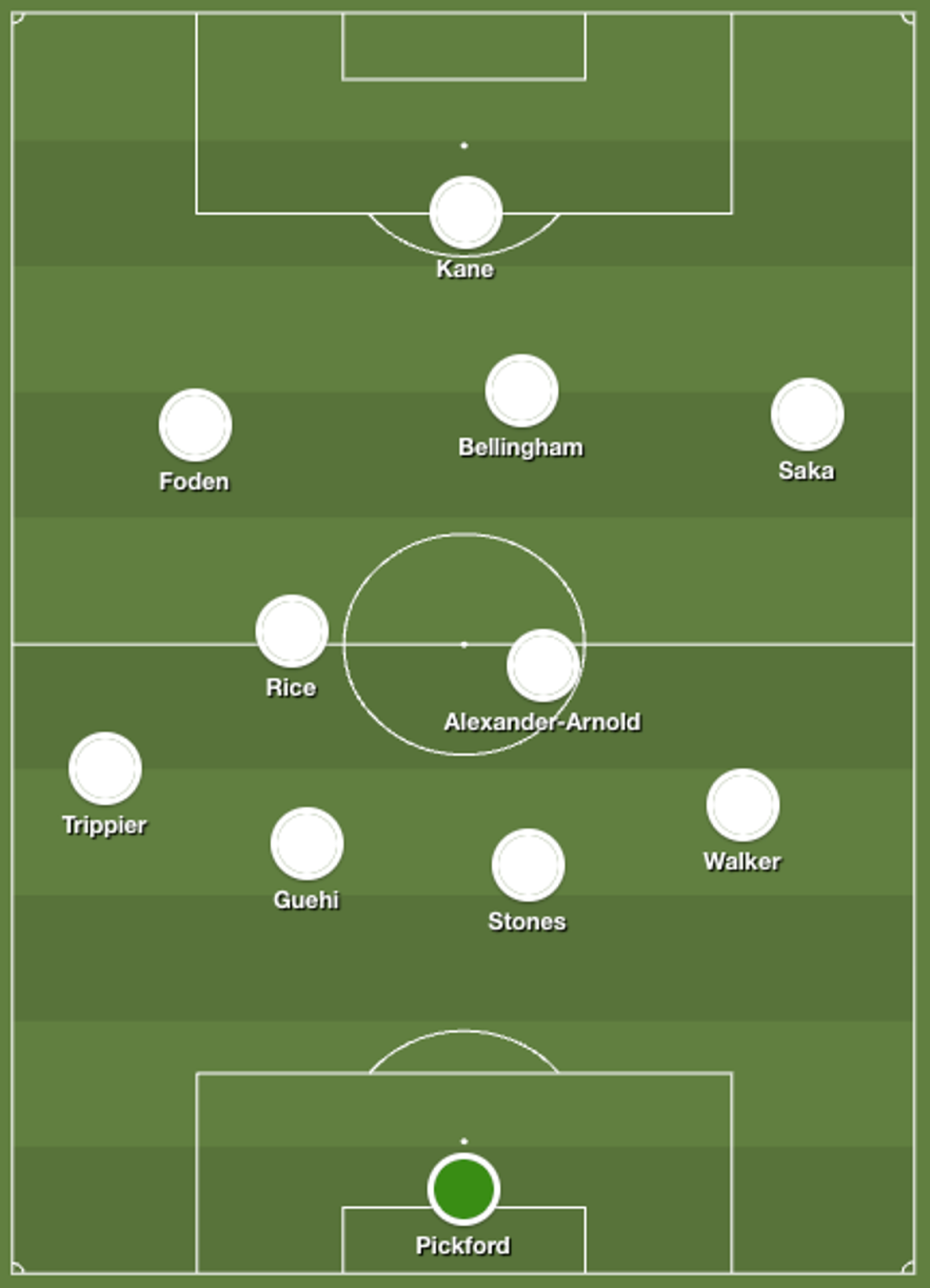
In what Southgate admits is probably his final tournament should England fail to win it, he takes a high-quality first XI to Euro 2024, albeit with an inexperienced back-up cast after dropping Rashford, Henderson, Grealish and other established names. The manager appears fully invested in his 4-2-3-1 shape and England’s final recasting is set.
From Dele and Lingard to Foden and Bellingham, England’s evolution from a hard-working, hard-running team to a free-flowing, controlling technical side is complete. After eight years of progress and restored hope, of setbacks and nearly moments, they just need something tangible to show for it.

